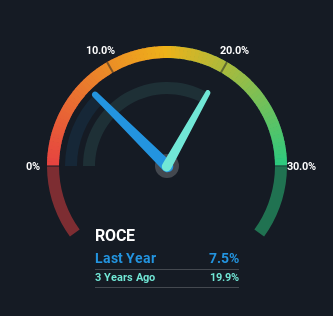- India
- /
- Basic Materials
- /
- NSEI:HEIDELBERG
HeidelbergCement India (NSE:HEIDELBERG) May Have Issues Allocating Its Capital

What financial metrics can indicate to us that a company is maturing or even in decline? A business that's potentially in decline often shows two trends, a return on capital employed (ROCE) that's declining, and a base of capital employed that's also declining. Basically the company is earning less on its investments and it is also reducing its total assets. In light of that, from a first glance at HeidelbergCement India (NSE:HEIDELBERG), we've spotted some signs that it could be struggling, so let's investigate.
Understanding Return On Capital Employed (ROCE)
For those that aren't sure what ROCE is, it measures the amount of pre-tax profits a company can generate from the capital employed in its business. The formula for this calculation on HeidelbergCement India is:
Return on Capital Employed = Earnings Before Interest and Tax (EBIT) ÷ (Total Assets - Current Liabilities)
0.075 = ₹1.4b ÷ (₹27b - ₹8.5b) (Based on the trailing twelve months to June 2023).
So, HeidelbergCement India has an ROCE of 7.5%. On its own that's a low return on capital but it's in line with the industry's average returns of 6.7%.
Check out our latest analysis for HeidelbergCement India

In the above chart we have measured HeidelbergCement India's prior ROCE against its prior performance, but the future is arguably more important. If you'd like to see what analysts are forecasting going forward, you should check out our free report for HeidelbergCement India.
What The Trend Of ROCE Can Tell Us
In terms of HeidelbergCement India's historical ROCE movements, the trend doesn't inspire confidence. Unfortunately the returns on capital have diminished from the 19% that they were earning five years ago. And on the capital employed front, the business is utilizing roughly the same amount of capital as it was back then. This combination can be indicative of a mature business that still has areas to deploy capital, but the returns received aren't as high due potentially to new competition or smaller margins. So because these trends aren't typically conducive to creating a multi-bagger, we wouldn't hold our breath on HeidelbergCement India becoming one if things continue as they have.
Our Take On HeidelbergCement India's ROCE
In summary, it's unfortunate that HeidelbergCement India is generating lower returns from the same amount of capital. Yet despite these concerning fundamentals, the stock has performed strongly with a 70% return over the last five years, so investors appear very optimistic. Regardless, we don't feel too comfortable with the fundamentals so we'd be steering clear of this stock for now.
Like most companies, HeidelbergCement India does come with some risks, and we've found 2 warning signs that you should be aware of.
While HeidelbergCement India may not currently earn the highest returns, we've compiled a list of companies that currently earn more than 25% return on equity. Check out this free list here.
Valuation is complex, but we're here to simplify it.
Discover if HeidelbergCement India might be undervalued or overvalued with our detailed analysis, featuring fair value estimates, potential risks, dividends, insider trades, and its financial condition.
Access Free AnalysisHave feedback on this article? Concerned about the content? Get in touch with us directly. Alternatively, email editorial-team (at) simplywallst.com.
This article by Simply Wall St is general in nature. We provide commentary based on historical data and analyst forecasts only using an unbiased methodology and our articles are not intended to be financial advice. It does not constitute a recommendation to buy or sell any stock, and does not take account of your objectives, or your financial situation. We aim to bring you long-term focused analysis driven by fundamental data. Note that our analysis may not factor in the latest price-sensitive company announcements or qualitative material. Simply Wall St has no position in any stocks mentioned.
About NSEI:HEIDELBERG
HeidelbergCement India
Engages in the manufacture and sale of cement in India.
Flawless balance sheet with moderate growth potential.
Similar Companies
Market Insights
Community Narratives



